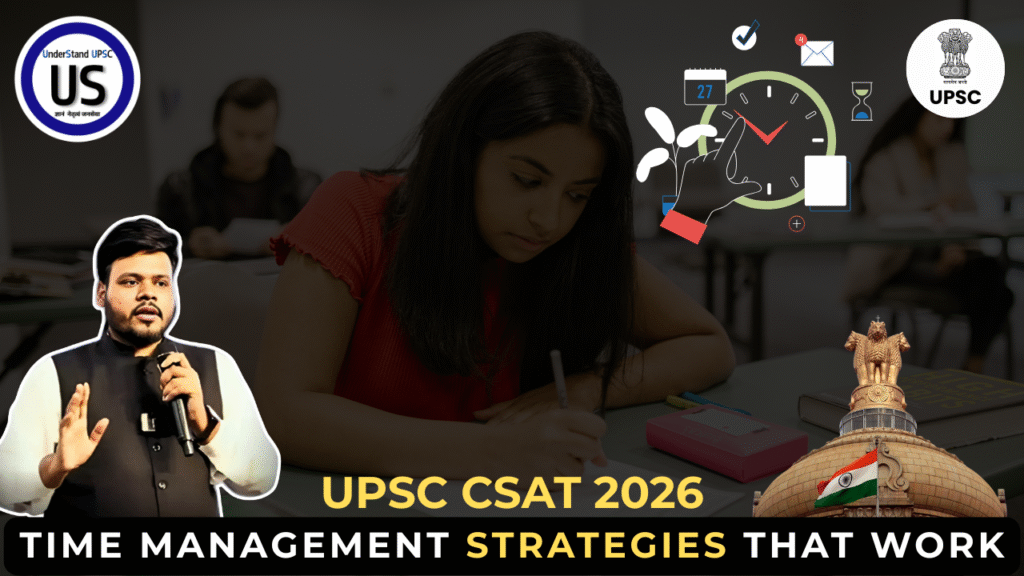
The UPSC CSAT paper is qualifying—you need just 33%. Yet, many aspirants stumble because they treat it lightly. In UPSC CSAT – time management can be a game-changer if you prepare & execute smartly. In this guide, I’ll walk you through proven time management strategies that work, based on market trends and insights from Understand UPSC and Satyam Jain Sir.
Why Time management in UPSC CSAT matters
Though CSAT doesn’t impact your mains ranking, failure to clear it invalidates your performance. With 120 minutes to attempt 80 questions, every second counts. Good time management ensures you:
- Focus on high-yield questions
- Avoid getting stuck on lengthy puzzles
- Attempt the minimum for qualifying—approximately 40–50 questions confidently
1. Assess your starting point
Start with a previous-year paper (PYQ). Time yourself strictly:
- Note how much time each question category takes
- Identify your strong areas (e.g. comprehension) vs weak areas (e.g. permutation & combination)
- Track how many questions you attempted in 120 min
This baseline helps shape your UPSC CSAT time management plan.
2. Divide and conquer the exam
Split the paper into sections:
- Comprehension & interpersonal skills
- Reasoning & quantitative aptitude
- Data interpretation & puzzles
Here’s a realistic timing plan:
- Comprehension: 35–40 minutes
- Reasoning: 25–30 minutes
- Quantitative aptitude: 25–30 minutes
- Buffer/revisit time: 5–10 minutes
3. Adopt a two-round exam strategy
Top strategists recommend attacking in two rounds:
- Round 1 (first 75 minutes)
Attempt all “sure-shot” questions—that you can solve in <2 minutes. Bubble as you go. - Round 2 (final 45 minutes)
Return to moderate-difficulty questions. Use elimination techniques. Keep bubble time inside the test window.
This minimizes overthinking and ensures all attempted answers are bubbled timely.
4. Master section-wise time drills
Comprehension (~40 min)
- Practice 3–4 passages daily
- Learn to quickly identify tone, main idea, and keywords
- Satyam Jain Sir suggests using editorials for speed and depth
Reasoning (~30 min)
- Use PYQs to find patterns
- Time yourself to solve 10–12 logical reasoning questions in 10 minutes
Quantitative (~30 min)
- Focus on high-yield topics: percentages, time-speed-distance, basic algebra, probability
- Drill questions in 2-minute blocks
5. Use mock tests for time audit
- Take 1 full-length test weekly
- Note how long each section takes and your accuracy
- Adjust target times based on results
A weekly time audit helps fine-tune your UPSC CSAT – time management plan.
6. Leverage micro‑target sessions
Spend daily 1-hour drills, focused on:
- 20 min reading comprehension
- 20 min reasoning
- 20 min quantitative/data interpretation
Quick daily practice reinforces your pace and builds stamina.
7. Set realistic micro‑targets
Each practice session, aim for:
- 40+ questions in timed mock
- Comprehension accuracy ≥ 80%
- Overall attempt of 50+ with ≥ 15 correct quantitative answers
These micro‑targets guide your UPSC CSAT time management and help track improvements.
8. Overcome time sinks
- Spotlockers like puzzles should be skipped early
- Bubble answers as soon as you solve—not at end
- Use an analog watch for periodic time checks
- Train to read questions calmly: circle keywords like “NOT,” “RECENTLY”
9. Revision and rest cycles
- After mock, revisit mistakes—especially time exceedances
- Take short breaks to avoid burnout
- In the last week before the exam, simulate exam day with full-time drills
10. Mental strategies on exam day
- Follow the two-round exam strategy(Above Point 3)
- Tackle strongest section first—usually comprehension
- Smile and stay calm; psychological ease improves time control
- Use the buffer wisely to review bubbled answers
Why this works
These approaches match strategies outlined by coaching leaders, including Understand UPSC and Satyam Jain Sir, and mirror market trends that favour focused, time-bound drills.
- Learn high‑yield topics in detail: Comprehensive CSAT strategy by Understand UPSC
- Take admission in our paid CSAT Program: https://student.understandupsc.com/store/courses/csat-cognito-for-upsc-cse-2026-beyond/68bfdcf291b92b472ff5e43b/
Quick checklist: UPSC CSAT time management
| Task | Frequency | Goal |
| Full-length mock | Weekly | Simulate exam conditions |
| Section drills | Daily | Build speed & accuracy |
| Time audits | Weekly | Track time improvements |
| Revision | After every mock | Strengthen weak spots |
| Exam simulation | 7 days before | Final readiness |
Key Takeaways
- UPSC CSAT time management is less about content and more about exam execution.
- Practice regular drills and mocks—track and refine time allocations.
- Use a two-round strategy and stay calm with mental tricks (e.g., smiling, tools).
- Train under realistic conditions to avoid surprises.
Final Words
Focus on UPSC CSAT time management to ensure you easily get past this qualifying paper. With structured practice, insights from Satyam Jain Sir & Saransh Gupta Sir & guidance from our CSAT program along with support of Understand UPSC, you’ll build confidence and keep the stress away on exam day.




